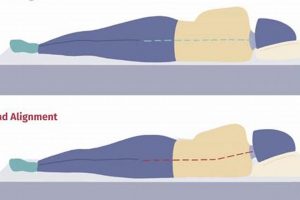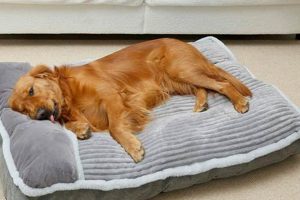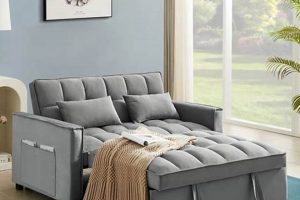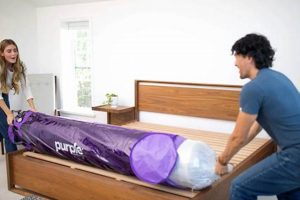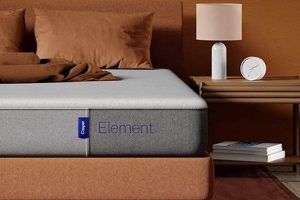The component under consideration constitutes the cushioned surface within a convertible seating unit intended for nighttime rest. It functions as a direct substitute for the original factory-provided item. For example, when the factory installed pad shows signs of wear, sags, or no longer provides adequate support, a new one can enhance the comfort and functionality of the sofa bed.
Acquiring an appropriate substitute offers numerous advantages, foremost among them being a significant improvement in sleep quality for users. A supportive and comfortable sleeping surface directly translates to better rest, mitigating aches and pains associated with inadequate support. Furthermore, maintaining a functional and comfortable sofa bed extends the overall lifespan of the furniture piece, presenting a cost-effective alternative to complete sofa replacement. Historically, these components were often thin and uncomfortable. Modern advancements in materials and manufacturing processes have led to the availability of options offering significantly improved comfort levels.
The following sections will delve into various aspects related to choosing the correct type, including considerations for dimensions, material composition, support structures, and factors that affect long-term durability. Different types of materials and construction will be examined to assist in selecting the optimum sleeping surface for individual needs and preferences.
Tips for Selecting a Replacement Sleeper Sofa Mattress
The selection of a new component for a convertible sofa necessitates careful consideration to ensure optimal comfort and longevity. The following guidelines are designed to assist in making an informed decision.
Tip 1: Measure Existing Dimensions Accurately: Prior to initiating a purchase, meticulously measure the existing sleeping surface’s length, width, and thickness. Incorrect dimensions can result in a component that does not properly fit within the sofa’s frame, rendering it unusable. Refer to the sofa bed’s manufacturer specifications, if available, to confirm measurements.
Tip 2: Prioritize Material Quality: Material composition directly impacts comfort, support, and durability. Options range from innerspring designs, offering traditional support, to memory foam constructions, which contour to the body. Latex provides a balance of support and responsiveness. Evaluate the density and construction quality of the internal materials to ensure longevity.
Tip 3: Evaluate Support System: The internal support system contributes significantly to overall comfort and prevents sagging. Consider features such as coil count for innerspring designs and foam density for foam-based options. A denser support system typically translates to greater support and resistance to compression over time.
Tip 4: Consider Thickness: The available space within the folded sofa configuration limits the maximum acceptable thickness. A component that is too thick may prevent the sofa from closing properly. Balance thickness with desired comfort levels, acknowledging that thinner options often compromise on support.
Tip 5: Research Warranty and Return Policies: Prior to purchase, thoroughly review the warranty offered by the manufacturer and the return policy of the retailer. This provides recourse in the event of manufacturing defects or dissatisfaction with the product’s performance.
Tip 6: Check for Certifications: Certifications such as CertiPUR-US indicate that the foam materials meet certain standards for content, emissions, and durability. These certifications offer assurance regarding the product’s quality and safety.
Tip 7: Read Customer Reviews: Consult customer reviews to gain insights into the real-world performance and durability of different components. Pay attention to feedback regarding comfort, support, and long-term use.
Selecting the appropriate replacement sleeping surface involves careful evaluation of dimensions, materials, support systems, and vendor policies. By adhering to these guidelines, a durable and comfortable addition to the convertible sofa can be found.
The subsequent section will address frequently asked questions related to the replacement process.
1. Dimensions
The dimensional characteristics are paramount when procuring a substitute interior sleeping surface for a convertible sofa. Precise measurements are not merely a recommendation, but an absolute prerequisite for ensuring proper fit and functionality. Failure to adhere to accurate dimensional specifications can render the new sleeping surface unusable, negating the intended benefits.
- Length and Width Consistency
The length and width must precisely match the internal frame dimensions of the sofa bed mechanism. Deviation from these specifications can result in either a component that is too small, leaving gaps and compromising support, or one that is too large, preventing the sofa from closing completely. For example, if the internal frame is 72 inches long and 54 inches wide, the substitute should adhere to these precise measurements. A discrepancy of even one inch can lead to significant operational difficulties.
- Thickness Compatibility
The thickness is a critical dimensional factor. Insufficient thickness may compromise comfort, while excessive thickness can impede the folding mechanism. Sofa bed designs incorporate specific tolerances for interior sleeping surface thickness. Exceeding these tolerances will prevent the sofa from properly closing and may damage the folding mechanism. As an illustration, a sofa designed for a four-inch thick surface may not accommodate a six-inch option, even if the length and width are correct.
- Corner Radius and Shape Conformance
Certain convertible sofa designs incorporate rounded corners or non-rectangular shapes. The substitute must accurately replicate these geometric features to ensure proper fit within the frame. Failure to account for corner radii or unconventional shapes can result in gaps, uneven support, and compromised comfort. In cases where the existing component has uniquely shaped corners, a template may be necessary to ensure accurate replication.
- Accounting for Internal Mechanisms
Internal mechanisms, such as support bars and folding hinges, may impinge upon the available space. Precise measurements must account for these internal obstructions to prevent interference. Failure to consider these elements can lead to premature wear or damage to both the mechanism and the substitute interior sleeping surface. For example, if a support bar runs across the center of the frame, the length measurement must accommodate this structural element.
In conclusion, accurate measurement and adherence to dimensional specifications are indispensable for the successful procurement and installation of a substitute interior sleeping surface for a convertible sofa. Neglecting these considerations will likely result in incompatibility and compromised functionality.
2. Material Composition
The selection of materials for a replacement convertible sofa interior sleeping surface fundamentally dictates its comfort, durability, and suitability for intended use. The composition directly affects factors such as support, temperature regulation, and resistance to wear and tear.
- Foam Density and Type
The density of the foam core, whether polyurethane, memory foam, or latex, significantly impacts support and longevity. Higher density foams provide greater resistance to compression and deformation over time, resulting in enhanced support and prolonged lifespan. For example, a high-density memory foam option contours to the body, alleviating pressure points, whereas a low-density polyurethane option may offer insufficient support and degrade quickly.
- Innerspring Coil Count and Gauge
In innerspring designs, the coil count and gauge (thickness) of the steel wires determine the level of support and motion isolation. Higher coil counts and lower gauge wires generally indicate a firmer, more supportive surface. A higher number of coils distributes weight more evenly, reducing pressure points and minimizing motion transfer. For instance, a unit with 300 coils of 13-gauge steel would typically offer greater support and stability compared to one with 200 coils of 15-gauge steel.
- Cover Fabric Durability and Breathability
The outer cover fabric protects the internal materials and contributes to overall comfort. Durable, tightly woven fabrics resist tearing and abrasion, extending the life of the sleeping surface. Breathable fabrics, such as cotton or specialized synthetics, promote airflow, preventing overheating and enhancing sleep quality. As an example, a cover made of tightly woven cotton offers both durability and breathability, while a cheaper, loosely woven synthetic fabric may be prone to tearing and trapping heat.
- Fire Retardant Compliance
Regulations often mandate the inclusion of fire-retardant materials. The type and application of these retardants can affect the overall comfort and chemical exposure. Options range from inherently fire-resistant fibers to chemical treatments. It is important to ensure the component complies with relevant safety standards without compromising comfort or exposing users to potentially harmful chemicals. For example, a sleeping surface may incorporate a layer of inherently fire-resistant modacrylic fiber, which provides flame protection without the need for chemical treatments.
In summary, careful consideration of the material composition is crucial when selecting a new sleeping surface for a convertible sofa. The interplay of foam density, innerspring specifications (if applicable), cover fabric properties, and fire-retardant compliance dictates the comfort, durability, and safety of the replacement. Investing in high-quality materials ensures a comfortable and long-lasting sleeping solution.
3. Support Structure
The framework underlying a replacement convertible sofa interior sleeping surface significantly influences its overall performance, comfort, and longevity. The support architecture provides essential stability, preventing sagging and ensuring uniform weight distribution. Its characteristics must be considered when selecting a suitable substitute.
- Coil Spring Systems
In innerspring designs, the coil spring system constitutes the primary support. The configuration, gauge, and density of the coils directly affect the level of support provided. A higher coil count and a lower gauge (thicker) wire generally translate to a firmer, more supportive surface. For example, pocketed coils, where each spring is encased in fabric, minimize motion transfer, reducing disturbances caused by movement during sleep. These systems are found in higher-quality replacement options, contributing to improved sleep quality.
- Foam Core Density
In foam-based designs, the density of the foam core dictates the level of support. Higher-density foams resist compression and deformation over time, providing superior support and preventing sagging. Different types of foam, such as polyurethane, memory foam, and latex, offer varying levels of support and conformability. For instance, a high-density memory foam core contours to the body, providing targeted support to pressure points and promoting spinal alignment. This is especially important for individuals with back pain.
- Wire Mesh or Platform Base
Many convertible sofa designs incorporate a wire mesh or platform base beneath the interior sleeping surface. This base provides foundational support, preventing the from sagging through the frame. The gauge and construction of the wire mesh or the material and design of the platform directly impact the overall stability and support. A robust wire mesh or a solid platform base is essential for maintaining proper alignment and preventing premature wear. These bases contribute to the overall longevity of the replacement component.
- Edge Support Reinforcement
Edge support reinforcement enhances the stability and prevents the edges from collapsing under pressure. Reinforced edges provide a more usable sleeping surface and prevent the sensation of rolling off the side. This reinforcement may involve the use of higher-density foam, steel rods, or other structural elements along the perimeter. For example, a replacement with reinforced edges offers a more stable and comfortable sleeping experience, especially for individuals who tend to sleep near the edge of the .
These elements of the support system, acting in concert, determine the ability of the replacement sleeper sofa pad to provide adequate spinal alignment and prevent premature wear. Selecting an option with a well-engineered support infrastructure will extend the lifespan of the convertible sofa and improve the quality of sleep.
4. Thickness
Thickness is a critical parameter when considering a replacement sofa bed sleeping surface. It dictates comfort, usability within the sofa’s folding mechanism, and overall compatibility. Selecting the appropriate thickness requires a careful balance between providing adequate support and ensuring seamless integration with the existing sofa frame.
- Maximum Foldability Constraints
Convertible sofas are designed with specific limitations on the thickness of the stored interior sleeping surface. Exceeding this maximum thickness will impede the folding mechanism, preventing the sofa from closing properly and potentially damaging the frame or mechanism. For example, a sofa designed for a four-inch thick surface will likely not accommodate a six-inch thick option, irrespective of other dimensional compatibility. Prioritizing foldability is crucial, as a non-closing sofa defeats its purpose.
- Minimum Comfort Threshold
While adhering to foldability constraints is paramount, the thickness must also provide sufficient cushioning and support for comfortable sleep. Inadequate thickness can result in pressure points, discomfort, and a compromised sleeping experience. For instance, a very thin, two-inch interior sleeping surface may lack adequate support, leading to back pain and restless sleep. Balancing foldability with comfort requires careful consideration of available materials and design. Thicker options generally offer improved comfort, provided they meet the foldability requirements of the sofa mechanism.
- Impact on Support Structure Integration
The thickness dictates the type and integration of internal support structures. Thinner options may necessitate simpler support systems, potentially compromising long-term durability and support. Thicker options allow for more complex and robust support systems, such as innerspring coils or multi-layered foam configurations. For instance, a thicker design might incorporate a layer of high-density foam for support and a layer of memory foam for comfort, while a thinner option might only accommodate a single layer of lower-density foam. The thickness enables integration of essential support components.
- Influence on Edge Support Integrity
Thickness influences the ability to incorporate effective edge support. Thicker options permit the inclusion of reinforced edges, preventing collapse and providing a more stable and usable sleeping surface. Thinner options often lack adequate edge support, leading to a sensation of rolling off the side and reduced overall comfort. As an example, a thicker may feature a high-density foam perimeter to prevent edge sagging, while a thinner option may lack this feature entirely. Adequate edge support enhances the sleeping experience.
Therefore, thickness represents a crucial trade-off between functionality and comfort in the context of a replacement sofa bed surface. The correct thickness ensures compatibility with the folding mechanism, enables integration of adequate support structures, and ultimately determines the quality of sleep provided by the convertible sofa. Careful consideration of the sofa’s design limitations and desired comfort levels is essential for selecting the optimal thickness.
5. Foldability
Foldability is an inherent characteristic of any sleeping surface designed for use within a convertible sofa mechanism. The capacity of a replacement unit to conform to the spatial constraints imposed by the folded sofa configuration is paramount to its successful integration and operation. A unit that fails to fold properly renders the sofa unusable as a seating element, negating the primary function of the convertible design. For example, a replacement unit that exceeds the allowable compression limits of the folding mechanism will prevent the sofa from latching securely, creating a safety hazard and compromising the furniture’s aesthetic appeal.
The materials and construction techniques employed directly influence its foldability. High-density materials, while offering enhanced support, may exhibit reduced flexibility, potentially hindering the folding process. Conversely, low-density materials may fold easily but provide inadequate support and exhibit premature wear. Design considerations, such as segmented construction or the incorporation of flexible hinges, can mitigate these trade-offs. Furthermore, the thickness plays a crucial role; an overly thick one, regardless of its material composition, will invariably compromise foldability. The structural integrity of the folding mechanism is inextricably linked to the physical properties of the installed unit. In some cases, attempting to force a non-folding surface into the closed position can damage the mechanism, necessitating costly repairs or complete sofa replacement.
Ultimately, the selection of a compatible replacement hinges on a thorough understanding of the original sofa’s design specifications and the physical characteristics of the candidate substitute. Proper foldability is not merely a desirable attribute; it is a fundamental requirement for ensuring the continued functionality and usability of the convertible sofa. The challenges lie in balancing foldability with desired comfort levels and long-term durability, a balance that requires careful consideration of materials, construction techniques, and dimensional constraints.
6. Durability
Durability, in the context of replacement interior sofa bed sleeping surfaces, constitutes a critical performance metric. It determines the lifespan of the component and directly impacts the long-term value proposition for the consumer. The inherent construction and materials employed define its ability to withstand repeated use and maintain its intended functional characteristics over an extended period.
- Material Resistance to Compression Set
Compression set refers to the permanent deformation of cushioning materials under sustained load. A durable replacement should exhibit minimal compression set, maintaining its original thickness and support characteristics despite repeated compression cycles from sleepers. For example, high-density foams and robust innerspring systems are selected to mitigate compression set, thereby extending the useful life of the interior sleeping surface. In contrast, low-density foams are prone to rapid compression set, resulting in diminished support and premature sagging. The selection of materials directly influences the resistance to this type of degradation.
- Fabric Abrasion Resistance
The cover fabric must withstand repeated abrasion from movement during sleep, preventing premature wear and tear. Durable fabrics, such as tightly woven synthetics or high-quality natural fibers, are chosen for their resistance to abrasion. A poorly chosen fabric will exhibit pilling, tearing, or seam failure, compromising the structural integrity of the interior sleeping surface. As an example, fabrics with a high Martindale abrasion rating are frequently specified to ensure long-term resistance to surface wear.
- Seam and Stitch Integrity
The seams and stitching must withstand repeated stress from folding and unfolding the sofa bed mechanism. Reinforced seams and high-tensile-strength threads are essential for preventing seam failure. A durable replacement will exhibit robust seams that resist unraveling or tearing under stress. For example, double-stitched seams with nylon or polyester threads are frequently employed to enhance seam integrity and prevent premature failure. The seams represent vulnerable points in the construction, requiring meticulous attention to detail.
- Resistance to Environmental Factors
A durable replacement should exhibit resistance to environmental factors such as humidity, temperature fluctuations, and exposure to light. These factors can degrade materials over time, leading to premature failure. For example, moisture-resistant fabrics and antimicrobial treatments can prevent the growth of mold and mildew, extending the lifespan of the interior sleeping surface. Similarly, UV-resistant materials can prevent fading and degradation from sunlight exposure. Proper selection of materials and treatments can mitigate the effects of environmental factors.
These facets of durability, considered collectively, determine the long-term performance and value of a replacement sofa bed interior sleeping surface. A durable unit will maintain its comfort and support characteristics over an extended period, providing a cost-effective and reliable sleeping solution. Conversely, a poorly constructed unit will exhibit premature wear and failure, necessitating frequent replacements and diminishing its overall value.
7. Comfort
The selection of a replacement interior sleeping surface for a convertible sofa is predominantly driven by the pursuit of enhanced comfort. The inherent design of convertible sofas often necessitates compromises in sleeping surface quality compared to traditional beds. A replacement aims to mitigate these compromises.
- Pressure Point Alleviation
A primary objective is the reduction of pressure points. Traditional sofa beds often utilize thin or uneven sleeping surfaces, leading to concentrated pressure on areas such as the shoulders, hips, and knees. Replacement components employing materials like memory foam or specialized innerspring systems distribute weight more evenly, alleviating these pressure points. For instance, a memory foam replacement conforms to the body’s contours, minimizing pressure on prominent joints and promoting spinal alignment. This, in turn, reduces discomfort and improves sleep quality. The design of the material directly impacts the amount of pressure point relief.
- Temperature Regulation
Maintaining a comfortable sleeping temperature is another crucial facet. Some materials, such as traditional polyurethane foam, can trap heat, leading to overheating and discomfort. Replacement options employing breathable fabrics or incorporating cooling gel infusions promote airflow and dissipate heat, resulting in a more comfortable sleeping environment. For example, a replacement with a cover fabric made of breathable cotton or incorporating cooling gel-infused memory foam can significantly reduce heat retention. Regulating temperature while sleeping results in greater comfort.
- Motion Isolation
Motion isolation is particularly important for individuals sharing a sofa bed. Inadequate motion isolation results in disturbances caused by movement during sleep, leading to fragmented sleep and reduced comfort. Replacement components employing pocketed coil innerspring systems or specialized foam constructions minimize motion transfer, allowing for undisturbed sleep. As an illustration, a replacement with pocketed coils isolates movement to individual springs, preventing disturbances from spreading across the sleeping surface. Reduced motion promotes longer durations of sleep.
- Surface Conformability and Support
The surface must strike a balance between conformability and support. Excessive firmness can lead to pressure points and discomfort, while insufficient support can result in spinal misalignment and back pain. Replacement components employing multi-layered constructions, combining conforming materials with supportive cores, provide an optimal balance. For example, a replacement with a layer of conforming memory foam atop a high-density support core offers both pressure relief and spinal support. Both support and flexibility are key.
The selection of a replacement for a convertible sofa fundamentally seeks to enhance comfort by addressing the inherent limitations of the original equipment. Improvements in pressure point alleviation, temperature regulation, motion isolation, and the balance between surface conformability and support, all contribute to a more restful and comfortable sleep experience.
Frequently Asked Questions
The following section addresses common inquiries regarding replacement interior sleeping surfaces for convertible sofas. The information provided aims to clarify key considerations for selecting an appropriate replacement.
Question 1: What factors determine the correct dimensions for a replacement unit?
The dimensions must precisely match the internal frame dimensions of the sofa bed mechanism. Length, width, and thickness must adhere to the manufacturer’s specifications or be accurately measured from the existing unit. Failure to adhere to dimensional specifications may render the replacement unusable.
Question 2: What are the primary material options and their respective benefits?
Common material options include innerspring, memory foam, and latex. Innerspring offers traditional support and bounce. Memory foam conforms to the body, alleviating pressure points. Latex provides a balance of support and responsiveness. The selection depends on individual preferences and support requirements.
Question 3: How does the support structure contribute to overall performance?
The support structure, whether coil springs or foam core density, dictates the level of support and resistance to sagging. A robust support structure ensures proper spinal alignment and prevents premature wear. Selecting an option with a well-engineered support infrastructure is essential for long-term performance.
Question 4: What thickness is recommended for a replacement?
The thickness must balance foldability with comfort. The maximum allowable thickness is dictated by the sofa bed’s folding mechanism. While greater thickness generally enhances comfort, exceeding the maximum limit will prevent the sofa from closing properly. Consulting the sofa’s specifications is advisable.
Question 5: What aspects of durability should be prioritized?
Prioritize material resistance to compression set, fabric abrasion resistance, and seam integrity. These factors determine the lifespan of the replacement and its ability to withstand repeated use and folding. Selecting a replacement with high-quality materials and robust construction ensures long-term durability.
Question 6: How can one assess the comfort level of a replacement prior to purchase?
Assess the comfort level by considering pressure point alleviation, temperature regulation, and motion isolation properties. Reviewing customer feedback and examining the material composition can provide insights into the comfort characteristics of the replacement.
In summary, selecting an appropriate replacement involves careful consideration of dimensions, materials, support structure, thickness, durability, and comfort. Adhering to these guidelines will facilitate the selection of a suitable and long-lasting replacement.
The subsequent section will provide guidance on the replacement process itself.
Conclusion
The preceding analysis has illuminated the critical factors involved in selecting a suitable interior sleeping surface for convertible sofas. Dimensional accuracy, material properties, support system integrity, and thickness compatibility represent essential parameters that directly impact the performance and longevity of a replacement sleeper sofa mattress. Comprehensive evaluation of these considerations enables informed decision-making.
The ultimate objective remains to optimize comfort and functionality within the constraints of the convertible sofa design. Future advancements in materials and manufacturing techniques may further refine the characteristics of these components. Proper selection and maintenance will ensure extended utility and enhanced user satisfaction.


